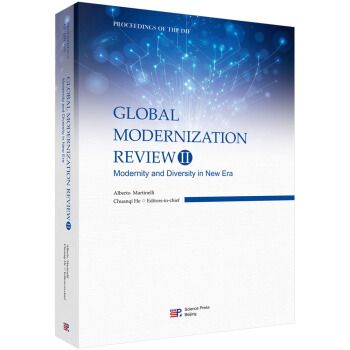《Glibal Modernization Review(2):Modernity and Diversity in Ne》是2018年科學出版社出版的圖書,作者是Alberto Martinelli。
基本介紹
- 中文名:Glibal Modernization Review(2):Modernity and Diversity in Ne
- 作者:Alberto Martinelli
- 出版時間:2018年
- 出版社:科學出版社
- 頁數:414 頁
- ISBN:9787030586261
- 定價:158 元
- 開本:16 開
- 裝幀:平裝
內容簡介,目錄,
內容簡介
Modernization has been a worldwide phenomenon since about the 18th century. It changed not only people's lives in all aspects including political, economic, social and cultural life, but also the human development, ecological and world system, etc. Modenuzation movement is just like an international marathon game of national development, in which the countries running ahead become developed countries while the rest become developing ones, and cultural diversity exists across time and space.
Today, almost all countries in the world are undergoing some kind of modernization consaously or unconsaously, and the modernization drive can also be set as a national goal directly or indirectly. The need has arisen to promote people's understanding of modemization process through the international comparative and interdisciplinary study.
The Second International Modernization Forum: Modemization and Diversity (IMF 2016) was held at China Hall of Science & Technology in Beijing on May 20-22, 2016. The China Center for Modernization Research of Chinese Academy of Sciences, International Soaal Saence Counal of UNESCO, Law & Development Academy of Peking University, and the Theory and Modernization magazine were the co-sponsors of the IMF 2016. The forum had received more than 60 papers and 90 scholars had attended the meeting. The Association for Modernization Studies (AMS) of China Soaety for Futures Studies (CSFS) was founded and Prof. Chuanqi He became the president of AMS of CSFS.
The Global Modernization Review (ID: Modernity and Diversity in New Era presents the proceedings of the IMF 2016. )It includes modemization and diversity in the new era, multiple modernities and cultural diversity, dynamics and paths of modernization, ecological modernization and green development, social modernization and human development, regional moderruzation and reduction of poverty and inequalities, and finally the appendix with world modernization indexes 2012.
The international modernization forum is an international arena for modernization study and its result is an important contribution to our collechve understanding of modernization phenomenon. It provides valuable guidance for the further study, and opens the way to significant international and interdisaplinary cooperation for modernization researches.
目錄
Contents
Foreword
Acknowledgments
Part One Modernization and Diversity in the New Era 1
Modernization and the Sustainable Development Goals: The Case of the European Union 3
Moral Capital: An Important Prerequisite for Social Change and Successful Modernization 26
Global Challenges of Modernization 33
Three Paths Towards National Modernization 46
What’s Modernization in the 21st Century: A Chinese Version 62
Part Two Multiple Modernities and Cultural Diversity 71
Harmonious Coexistence of Tradition and Modernity — Inspirations from the Lasting Survival of the Amish Community in Modern American Society 73
Cultural Diversity and Social Contradictions of the Modernization 77
Culture Trend of Modernization as Reflected in Office Space Design 80
Consolidation, Integration, Modernization: From the Shaping of the Framework “Mitteleuropa” to the European Union 85
Global Modernization Trend in the Perspective of Human History 90
Urban Diversification and Social Diversity 108
Attitudes Toward Modernization and Rural‐Urban Relationship: A Comparison Between Modern China and Japan 115
Three Trends of Chinese Learning and Construction of Multi modernity in China 123
The Contours of Russian Modernization 134
Part Three Dynamics and Paths of Modernization 141
Modernization of Russia: Contemporary Trends 143
How Did Romania Become Modern? A Southeastern European Experience During the 20th Century 150
Specifics and Differentiation of the Balance of Modernization Processesin Russian Regions 161
Progressive Reform: Path of Political Modernization in Britain and Its Inspirations 170
The Guarantee of Progress and Harmony: Modernization and Livelihood Improvement in Modern America 177
International Inequality and the Global Crisis: Managing Markets for Sustainable Growth 184
A New Institutional Economy Growth Theory from the Angle of the Economic Rights 201
A Historical Review of World Industrial Modernization 208
Challenges and Policy Suggestions on China’s Agricultural Modernization 220
Analysis on Diversity and Imbalance of Service ModernIzation :A View Based on the Second Modernization Evaluation 228
Part Four Ecological Modernization and Green Development 239
Staging Pathways Towards Ecomodernity 241
Ecological Modernization and Resilience of Resource Communities 260
Ecological Civilization Construction Demonstration Areas in China from a Three‐dimensional Theoretical Perspective 269
After Paris: Global Trend of Green Development and China’s Ecological Modernization Strategy 284
Establishment of Low‐carbon City Construction Policy Toolkit and Analysis of the Policy Tools’ Effectiveness 295
Rural Ecological Modernization: Evaluation Indicators and Case Study 302
Time to Reinstate Poise of Nature 310
On Promoting the Construction of Ecological Civilization from the Perspective of Ecological Modernization Theory: A Case Study of the Wuhan International Garden Expo 312
Part Five Social Modernization and Human Development 319
Social Modernization and Quality of Life Measurement in Russia 321
A Study on China’s Structural Reform in Social Fields 326
Historical Experience of Modernization in Russia 335
The Deepening of the Division of Labor, Social Structure and the Modernization of National Governance 343
The Youth Entrepreneurship as a Factor of Social Modernization of Society 351
To Explore a Chinese Discourse of Modernity Research Paradigms 358
Part Six Regional Modernization & Reduction of Poverty and Inequalities 365
Socio‐economic Development of Region in the Context of Modernization Processes: A Case Study of St. Petersburg 367
Regional Modernization and Sustainable Development in a Mining Region from the Habsburg Monarchy (Transylvania) in 1750‐1914 376
Evaluation of Regional Modernization of China’s 52 Regions 388
Interactive Mechanism Between Regional Economic Integration and Regional Modernization 400
Appendix 410

